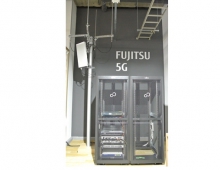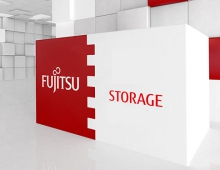
Fujitsu Developed New Material for 65nm 256Mbit FeRAM
Fujitsu Microelectronics America announced that the Tokyo Institute of Technology, Fujitsu Laboratories, and Fujitsu Limited have jointly developed a new material for a new generation of non-volatile Ferroelectric Random Access Memory (FeRAM).
FeRAM combines the fast operating characteristics of DRAM and SRAM with flash memory's ability to retain data while powered off. FeRAM, like MRAM, is a low power, nonvolatile memory design that possesses an array structure allowing for the one-transitor memory
cell density of standard DRAM. While MRAM derives its memory store capability from the
presence of a magnetic junction tunnel, FeRAM utilizes the properties of ferroelectric
capacitors to effectively detect the positioning of electrical dipoles within
ferroelectric material. Unlike DRAM memories, which refresh their capacitors
periodically, ferroelectric memories only refresh the arrays after a read is performed,
this because the read destroys the content of the cell. If there is no read, the dipoles
never flip, hence no recharge cycles are required. This allows FeRAM memory to operate
at low power.
The material is a modified composition of Bismuth Ferrite (BiFeO3 or BFO), which enables data storage capacity up to five times greater than the materials currently used in FeRAM production.
New FeRAMs can be produced with Fujitsu's 65nm process technology using the BFO-based material in a device structure similar to the one used to build FeRAMs using 180nm technology. FeRAMs using this material can provide memory cell capacity up to 256Mbits.
The new FeRAMs will deliver the very low power consumption and high speeds required for new generations of personalized mobile electronic products such as IC cards, which must be small, easy to use, and provide very high security. Engineering sample shipments are planned for 2009.
Fujitsu began mass production of FeRAM in 1999, and has shipped several hundred million chips of embedded and stand-alone FeRAM as of March 2006, including 1Mbit stand-alone FeRAM chips.
FeRAMs built using 65nm technology can be produced using Mn-doped BFO, with the similar device structure of the FeRAM being produced using 180nm technology. FeRAMs using this new material will also provide significant scalability, enabling large memory capacity up to 2014.
With further development of BFO, large-capacity 256Mbit FeRAMs can be realized that reach densities of two orders higher compared with the current capacity of 1Mbits. With this increased density, FeRAM applications is expected to expand not only in the security applications, but also in new domains like "Quick-On-Computer," under which a computer can be immediately ready to use after turning on. FeRAMs also can be used in electronic paper devices, which let users browse and read a large volume of information traditionally written on plain paper.
Details of the material and process were presented at the meeting of the Japan Society of Applied Physics (JSPS) in March 2006 in Tokyo, and also at the International Symposium on Integrated Ferroelectrics (ISIF) in April 2006 in Hawaii. For the joint research, Tokyo-Tech is supported in part by a grant from the Ministry of Education, Culture, Sports, Science and Technology (MEXT) via the Japan Science and Technology Agency (JST).
Fujitsu will continue its research and development programs to provide FeRAMs for embedded LSI. Research on the BFO material and implementation technology needed for incorporating BFO capacitors in FeRAM also continues.
Material details
BFO is a ferroelectric material composed of Bismuth, Iron and Oxygen atoms with a perovskite structure. Lead Zirconate Titanate (PZT or Pb(Zr,Ti)O3) is now used as a ferroelectric material but it has a lower-charge storage capability, so it also has limited scalability. The technology limits of PZT are expected to occur at the 130nm node, because as cell area decreases, higher polarization is required. This limit is expected to be reached in 2009.
An Mn-doped BFO thin-film capacitor was developed with the dual functions of decreasing leakage current and 180-220 C/cm2 of switching charge, Qsw, which is equivalent to twice the remanent polarization, 2Pr. These results clearly indicate significant scalability potential for future technology nodes.
The material is a modified composition of Bismuth Ferrite (BiFeO3 or BFO), which enables data storage capacity up to five times greater than the materials currently used in FeRAM production.
New FeRAMs can be produced with Fujitsu's 65nm process technology using the BFO-based material in a device structure similar to the one used to build FeRAMs using 180nm technology. FeRAMs using this material can provide memory cell capacity up to 256Mbits.
The new FeRAMs will deliver the very low power consumption and high speeds required for new generations of personalized mobile electronic products such as IC cards, which must be small, easy to use, and provide very high security. Engineering sample shipments are planned for 2009.
Fujitsu began mass production of FeRAM in 1999, and has shipped several hundred million chips of embedded and stand-alone FeRAM as of March 2006, including 1Mbit stand-alone FeRAM chips.
FeRAMs built using 65nm technology can be produced using Mn-doped BFO, with the similar device structure of the FeRAM being produced using 180nm technology. FeRAMs using this new material will also provide significant scalability, enabling large memory capacity up to 2014.
With further development of BFO, large-capacity 256Mbit FeRAMs can be realized that reach densities of two orders higher compared with the current capacity of 1Mbits. With this increased density, FeRAM applications is expected to expand not only in the security applications, but also in new domains like "Quick-On-Computer," under which a computer can be immediately ready to use after turning on. FeRAMs also can be used in electronic paper devices, which let users browse and read a large volume of information traditionally written on plain paper.
Details of the material and process were presented at the meeting of the Japan Society of Applied Physics (JSPS) in March 2006 in Tokyo, and also at the International Symposium on Integrated Ferroelectrics (ISIF) in April 2006 in Hawaii. For the joint research, Tokyo-Tech is supported in part by a grant from the Ministry of Education, Culture, Sports, Science and Technology (MEXT) via the Japan Science and Technology Agency (JST).
Fujitsu will continue its research and development programs to provide FeRAMs for embedded LSI. Research on the BFO material and implementation technology needed for incorporating BFO capacitors in FeRAM also continues.
Material details
BFO is a ferroelectric material composed of Bismuth, Iron and Oxygen atoms with a perovskite structure. Lead Zirconate Titanate (PZT or Pb(Zr,Ti)O3) is now used as a ferroelectric material but it has a lower-charge storage capability, so it also has limited scalability. The technology limits of PZT are expected to occur at the 130nm node, because as cell area decreases, higher polarization is required. This limit is expected to be reached in 2009.
An Mn-doped BFO thin-film capacitor was developed with the dual functions of decreasing leakage current and 180-220 C/cm2 of switching charge, Qsw, which is equivalent to twice the remanent polarization, 2Pr. These results clearly indicate significant scalability potential for future technology nodes.




















